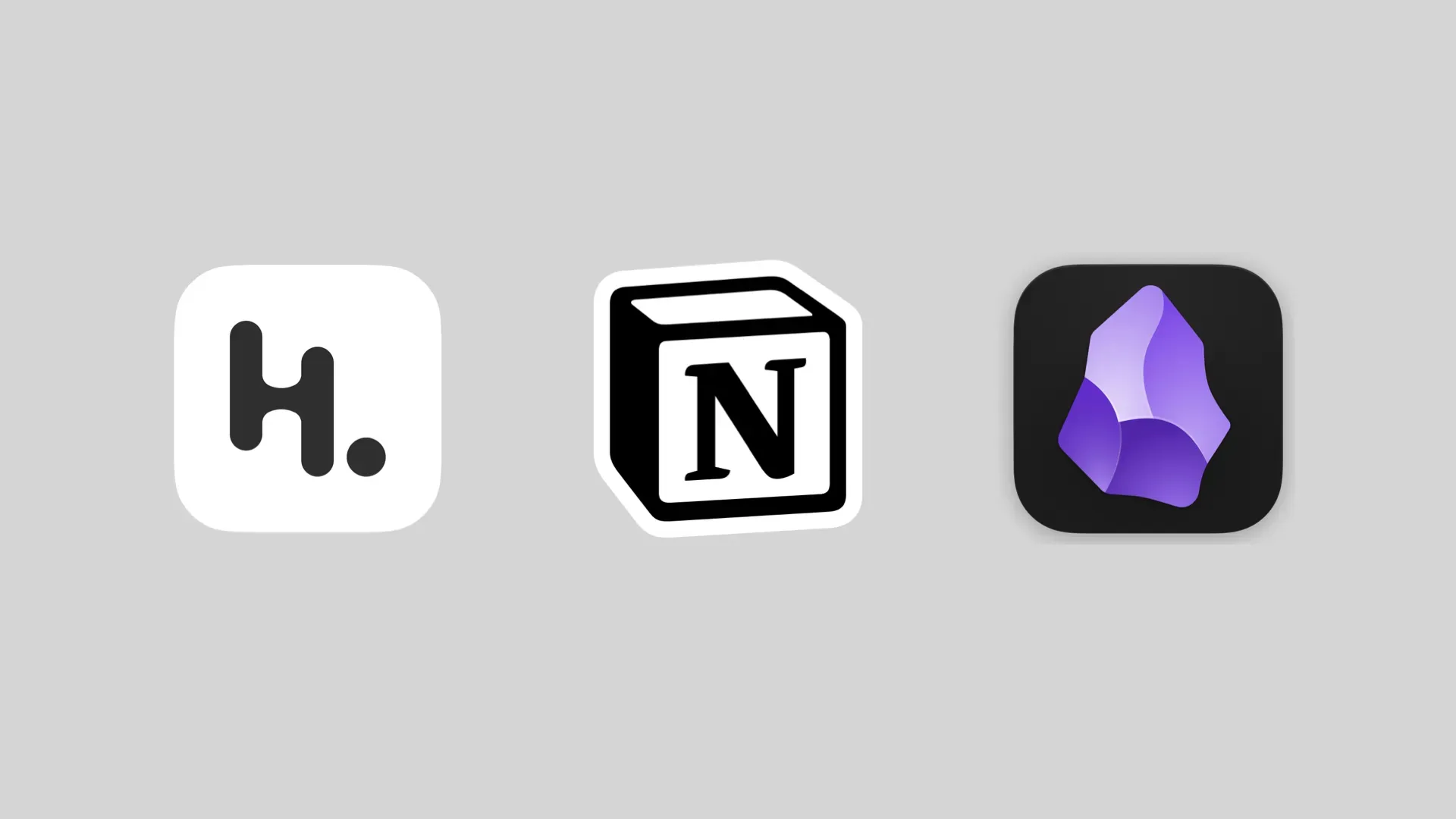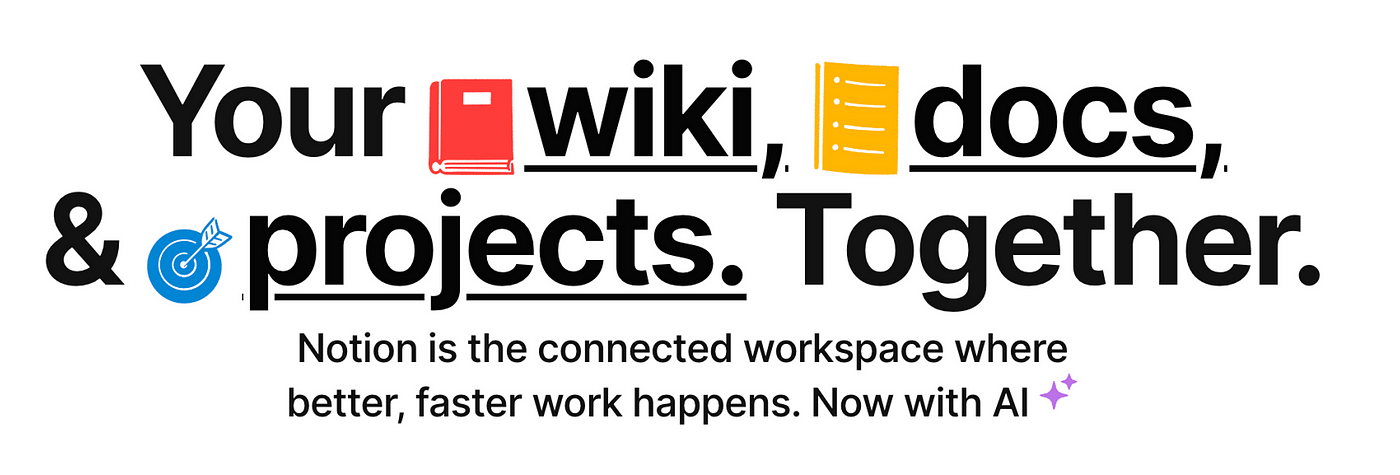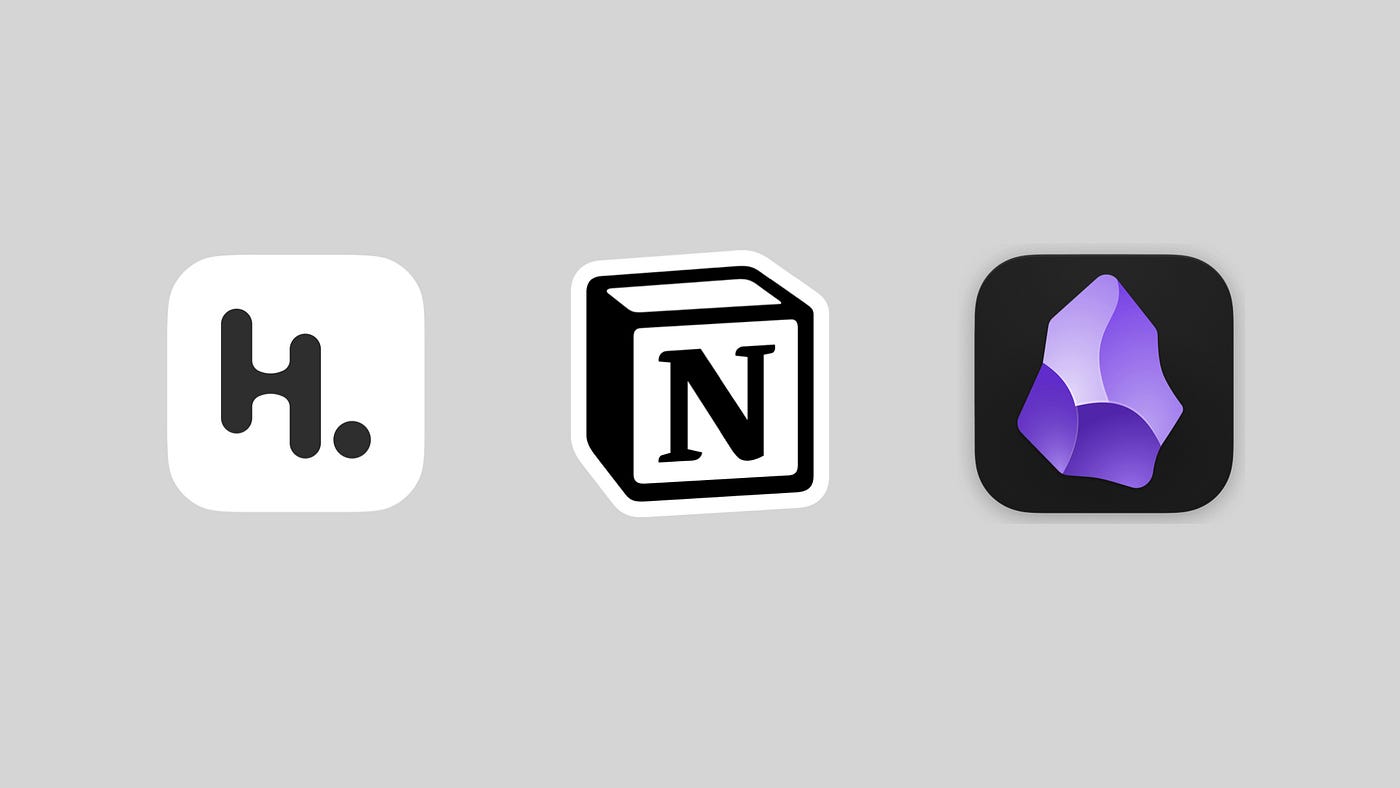Heptabase vs Notion vs Obsidian
只有在把產品定位成學習軟體時,我們才能真正把注意力聚焦在「幫助用戶更好地學習」,而非「幫助用戶記更多的筆記」或「幫著用戶打造生產力系統」。

Introduction
Since I started building Heptabase, many people have asked me: Which is better among Heptabase, Notion, and Obsidian? How do these tools differ? What unique advantages does Heptabase offer? In this article, I will answer these questions from the perspective of a co-founder of Heptabase.
The Right Way to Evaluate Product: Understand Core Use Cases
When evaluating whether a product is right for you, try not to just look at the number of features but whether the product can solve the problems you want to solve. Most products will state the main problem they want to solve and their core values on their official websites. Therefore, I suggest that you first read the product descriptions on their websites to understand which among Heptabase, Notion, and Obsidian might suits you better.
First, let’s look at how Notion describes its product on its website:

From this description, we can see that Notion emphasizes the use cases of wikis, documents, and projects. It claims to connect all of this information to help teams access and use it more efficiently. Based on my experience, the collaborative database is the core feature that empowers everything in Notion. All Notion templates are built around databases and hierarchical pages.
In Notion, meeting notes, project development boards, and team wikis each have their own databases, and you can link these databases to each other. On the other hand, engineering teams’ Github pull requests, design teams’ Figma files, data teams’ Amplitude charts, and customer support team’s Loom videos can all be integrated and embedded into Notion’s databases and pages, so that the team can centralize all the data in one place.
Next, let’s look at how Obsidian describes its product on its website:

From this description, we can see that Obsidian’s main use case is to “sharpen your thinking,” and it emphasizes the core values of being “private” and “flexible.” Unlike Notion’s team collaboration focus, Obsidian focuses on individual use. It allows you to set up a productivity system that assists your thinking while providing complete encryption solutions for those who prioritize privacy over everything else.
Based on my experience, Obsidian’s flexibility stems from its philosophy: “All notes are Markdown files.” If you are a developer, you can build a rich plugin ecosystem around your Markdown files in Obsidian. Most Obsidian plugins add special YAML syntax to the Markdown files, which is then parsed into specific views to display your notes. Depending on your needs, you can choose the plugins you want to combine and build your customized productivity system.
Lastly, let’s look at how Heptabase describes its product on its website:

From this description, the term “make sense” appears twice, revealing the core purpose of Heptabase: to help you acquire a deep understanding of complex topics you are learning or researching.
With this core purpose, all features in Heptabase revolve around the “whiteboard” as a medium for empowering your visual thinking capabilities. Whether you’re jotting down fleeting thoughts in a journal, highlighting and annotating a PDF, integrating data from Readwise, or building a card database with tags and properties, you can easily bring all the information you have into Heptabase’s whiteboard to think. You can use arrows, sections, mind maps, and nested whiteboards to facilitate your thinking and acquire a deep understanding of the topic. You can also use the thinking frameworks you have built on whiteboards to produce writing.
As of August 2023, based on the official descriptions of these three products and my experience using them, here are my personal opinions:
- If you’re looking for a product to manage team projects, documents, and wikis, I believe Notion, with its robust collaborative database, is perfect for you and your team.
- If team collaboration is not a priority and you are looking for a tool for personal notes, and you are interested in exploring Obsidian’s plugin ecosystem built around Markdown and YAML to set up a customized productivity system, then Obsidian is perfect for you.
- If you are heavily focused on learning and research and are looking for a tool that can help you acquire a deep understanding of your learning topic, Heptabase’s intuitive interface and out-of-the-box visual learning workflow might be the best fit for you. You won’t need to spend time figuring out how to set up a productivity system. Instead, you can dive right into concentrated learning on the first day.
Heptabase is More of a Learning Tool than a Note-taking Tool
When compared to Notion and Obsidian, I believe the most distinctive thing about Heptabase is that it is more of a dedicated learning tool rather than just a note-taking tool. This was an essential principle we adhered to when designing and building Heptabase: only by positioning the product as a learning tool can we truly focus on “helping users learn better” rather than “helping users take more notes or build a productivity system.”
A good learning tool should allow you to spend all your time focused on learning every time you use it. After using it, you should acquire a deeper understanding of the topic you care about. I’ve taken detours with many note-taking and productivity tools and found that putting too much focus on note format or structure can be a barrier to effective learning. That’s why design is crucial to us. We have dedicated thousands of hours to making sure that all features are carefully and cohesively designed around a better method for learning and put together into an intuitive interface, so users don’t have to do anything unrelated to learning.
The most common feedback we’ve received from Heptabase users is that they can immediately get into the flow of thinking as soon as they enter the app, focusing on learning and researching the topics they care about, and forgetting that they are actually using software. Notes become a natural byproduct of the learning and research process, but through Heptabase’s workflow, these notes also hold significant long-term value and utility. If you’re interested in the learning experience on Heptabase, you can refer to the two videos I recorded while using the app. The notes for the first video are in English, and those for the second are in Mandarin. Both videos are very long and have no audio.
In these two videos, you’ll see that while I appear to be taking notes, what I’m actually doing is breaking down the vast amount of information I’ve absorbed from reading a book or taking a lecture into conceptual units that I can understand. I then describe these concepts in my own words and eventually group and connect them visually to understand their underlying structure.
On the surface, I spent hours taking notes, but in reality, I spent those hours learning and thinking. After finishing my learning, not only do I have a deep understanding of the topic, but my thought process is also preserved in the form of notes. In the future, whenever I want to review or use the knowledge I’ve acquired, I can quickly scan these notes to retrieve my thinking during the initial learning process.
If you want to learn more about how I use Heptabase to learn, check out this article: The best way to acquire knowledge from readings.
Conclusion
Finally, I know you read this article because you want to know how Heptabase differs from Notion and Obsidian. What are the feature differences? What are the pros and cons of each?
However, instead of asking, “Does this product have a whiteboard feature?” or “Does that product have a bi-directional linking feature?”, I think a better question is “What kind of workflow does this product aim to provide?” and “Can this workflow solve my problem?”
Features are just one component of a complete workflow. The same feature can have vastly different utilities and values under different workflows. Therefore, this article aims to compare Heptabase, Notion, and Obsidian not based on features, but based on the workflow of the product and the problems they aim to solve, and how each product’s core features support its core value proposition.
Through the videos and articles above, you’ll notice that while there are many products that can visualize text, most focus on drawing, brainstorming, and meeting use cases. In contrast, Heptabase is one of the few products dedicated to helping you smoothly deconstruct and reassemble knowledge during learning and research. We believe that the deep learning workflow Heptabase embodies can profoundly impact your learning outcomes. If you’re interested in this, we welcome you to try it yourself!

前言
從開始打造 Heptabase 至今,很常有人會問我:Heptabase 跟 Notion、Obsidian 誰比較好?這些工具有什麼不同?Heptabase 具備什麼獨特的優勢?在這篇文章裡,我會以 Heptabase 共同創辦人的視角去回答這個問題。
評估產品的正確方式:暸解核心使用場景
若要評估一個產品適不適合你,要盡量避免只看它功能的多寡,而忽略了這個產品有沒有辦法解決你想解決的問題。大部分產品會將他們最專注解決的問題與最重視的價值寫在他們的官網上,因此如果要知道 Heptabase、Notion 和 Obsidian 哪一個可能更適合你,我覺得一個很好的方式是先去看它們官網的產品描述。
我們首先來看 Notion 在官網上寫的產品描述:

在這個描述中,我們可以看到 Notion 強調了維基(wiki)、文檔(docs)、專案(projects)等關鍵字,並且提到它可以將這些資訊緊密地連結在一起,讓團隊能夠更好、更快地找到與使用它們。根據我的使用經驗,這個描述背後的核心功能是它的協作資料庫,Notion 的所有範本都是以資料庫和階層頁面為中心去打造的。
在 Notion,會議記錄文檔、專案開發看板、團隊維基通通都有各自的資料庫,而這些資料庫之間能彼此關聯。舉凡工程團隊的 Github Pull Requests、設計團隊的 Figma Files、數據團隊的 Amplitude Charts、客服團隊的 Loom Videos 通通都能對接並嵌入 Notion 的資料庫和頁面裡頭,讓團隊可以在一個工具裡看到所有的資料。
接下來,讓我們看一下 Obsidian 在官網上寫的產品描述:

在這個描述中,我們可以看到 Obsidian 最想讓用戶達到的目標是「Sharpen your thinking」,並且注重「私人」(private)與「彈性」(flexible)這二個核心價值。相較於 Notion 的團隊協作,Obsidian 更強調個人使用,讓一個人可以按照自己的想法來搭建協助自己思考的筆記系統,同時對於隱私要求高的用戶提供更完整的加密方案。
根據我的使用經驗,Obsidian 的彈性體現在「一切筆記皆為 Markdown 檔案」這個產品哲學上。如果你是一個工程師,你可以在 Obsidian 中圍繞 Markdown 檔案打造豐富的插件生態系來擴充它的功能。Obsidian 的大部分插件會在 Markdown 檔案上添加特殊的 YAML 語法,然後再將這些語法解析成特定的視圖來呈現你的筆記。需求不同的用戶在使用 Obsidian 時,可以選擇安裝他們想要的插件來獲得他們需要的功能,再用這些功能來搭建他們想要的客製化系統。
最後,讓我們看一下 Heptabase 在官網上寫的產品描述:

在這個描述中,我們可以看到「理解」(make sense)出現了二次,這也揭示了 Heptabase 的核心用途:幫助你對你在學習或研究的複雜主題建立深度的理解。具體達成的方式,則是透過視覺化(visually)的方式,賦予(empowers)你這樣的深度理解能力。
基於這樣的價值觀與目標,Heptabase 裡面的所有功能都是圍繞著「白板」這個能承載豐富視覺資訊的媒介去打造的。不論你在日誌紀錄零散的想法、在 PDF 上面畫線與註解、將 Readwise 的資料對接進來,還是用標籤和屬性來建立卡片資料庫,你在 Heptabase 中建立的一切資訊全都可以自然地被匯集到白板上,利用箭頭、分區、心智圖、層狀白板來梳理你的思路,對你在乎的主題建立深度理解。當你要寫作時,你也可以以白板上的思考架構為基礎,搭配右側欄的功能來撰寫文章。
現階段(2023/08),根據這三個產品的官方描述,以及我使用這三個產品的經驗,以下是我的個人看法:
- 如果你希望找到一個軟體來管理團隊協作的專案進度、文件和維基,我認為 Notion 和它強大的協作資料庫很適合你(以及你的團隊)。
- 如果你不太需要團隊協作,希望找到一個軟體來管理私人筆記,並且明確知道自己想要搭建什麼樣的筆記系統,也樂於探索和研究 Obsidian 基於 Markdown 和 YAML 的插件生態系,我認為 Obsidian 和它豐富的插件系統很適合你。
- 如果你非常注重學習和研究,希望找到一個軟體來幫助你對學習和研究的主題建立深度理解,並且不想花時間研究怎麼搭建筆記系統,而是希望能快速進入專注的學習狀態,我認為 Heptabase 的直覺介面與開箱即用的視覺化學習工作流很適合你。
比起筆記軟體, Heptabase 更像是一個學習軟體
相較於 Notion 和 Obsidian,我認為 Heptabase 最不同的地方在於,比起筆記軟體,它更像是一個專門幫助你學習的軟體。這是我們設計和打造 Heptabase 時一直遵循的重要原則:只有在把產品定位成學習軟體時,我們才能真正把注意力聚焦在「幫助用戶更好地學習」,而非「幫助用戶記更多的筆記」或「幫著用戶打造生產力系統」。
一個好的學習軟體應該要讓你在每一次使用它時都能把全部的時間專注在學習上,並且在使用過後感受到你對你在乎的主題獲得了更深的理解。我曾在許多筆記軟體與生產力工具身上繞過遠路,發現對格式或架構的追求容易成為學習成效的路障,也因此我們在設計 Heptabase 時投入了數千小時在將重要的功能透過直覺且合理的介面邏輯自然地融合在一起,讓用戶不需要做任何與學習無關的事情。
Heptabase 用戶最常給的反饋,就是他們可以一打開產品就進到「心流狀態」,專注在學習和研究他們在乎的主題,而忘記他們其實正在使用一個軟體。筆記則是用戶在學習和做研究的過程中自然生出的產物,但透過 Heptabase 的機制,這些筆記也產生了很高的長期價值和用途。如果你對在 Heptabase 上的學習體驗有興趣,可以參考以下二支我在使用 Heptabase 學習時錄的影片。第一支影片的筆記是英文的,第二支則是中文的,二支影片都非常長並且沒聲音。
在這二支影片中,你會發現雖然我看似在做筆記,但我實際在做的事情是在看了一本書或是上完一門課程後,把我吸收的大量資訊拆解成我能理解的概念單位,接著用我自己的語言去描述這些概念,最後再把這些概念串聯起來,用視覺化的方式去理解它們的底層結構。
表面上我花了好幾個小時在記筆記,但實際上這些時間都是我在學習和思考的時間。而當我學習完了以後,我不止對這個主題有了深度的理解,我的思考脈絡也被以筆記的形式保存下來了。未來每當我想要回顧或使用我過去所學的知識時,我永遠都可以快速地掃過這些白板來重新回溯我當初學習時的思考狀態。
如果你想要更深入地暸解我用 Heptabase 學習的方法,歡迎參考這篇文章:The best way to acquire knowledge from readings。
總結
最後,我知道很多人會點開這篇文章是因為想知道 Heptabase 與 Notion 和 Obsidian 到底有什麼不一樣?功能有什麼差異?各自有哪些優缺點?
然而,比起問「這個產品有筆記視覺化的功能嗎?」、「那個產品有雙向連結的功能嗎?」,我認為比較合適的問法是「這個產品想要帶給你什麼樣的工作流?」、「這個工作流是否能解決我的問題?」
功能只是完整工作流(workflow)的一環,相同的功能在不同的工作流下體現出來的用途和價值會非常不一樣。因此這篇文章嘗試不從功能出發,而是以產品的工作流以及產品想解決的問題來比較 Heptabase、Notion 和 Obsidian 的差異,並探討每個產品的核心功能如何支撐這個產品的核心價值。
透過上面的影片和文章你會發現,雖然網路上有許多可以用來視覺化文字的產品,但大部分的產品主要聚焦於繪圖、發想和會議討論的場景上,而 Heptabase 是極少數專注於幫助你在學習和做研究時流暢地拆解和重組知識的產品。我們相信 Heptabase 提倡的深度學習的工作流可以徹底改變你學習的成效。如果你對此感興趣,歡迎親自來體驗看看!
